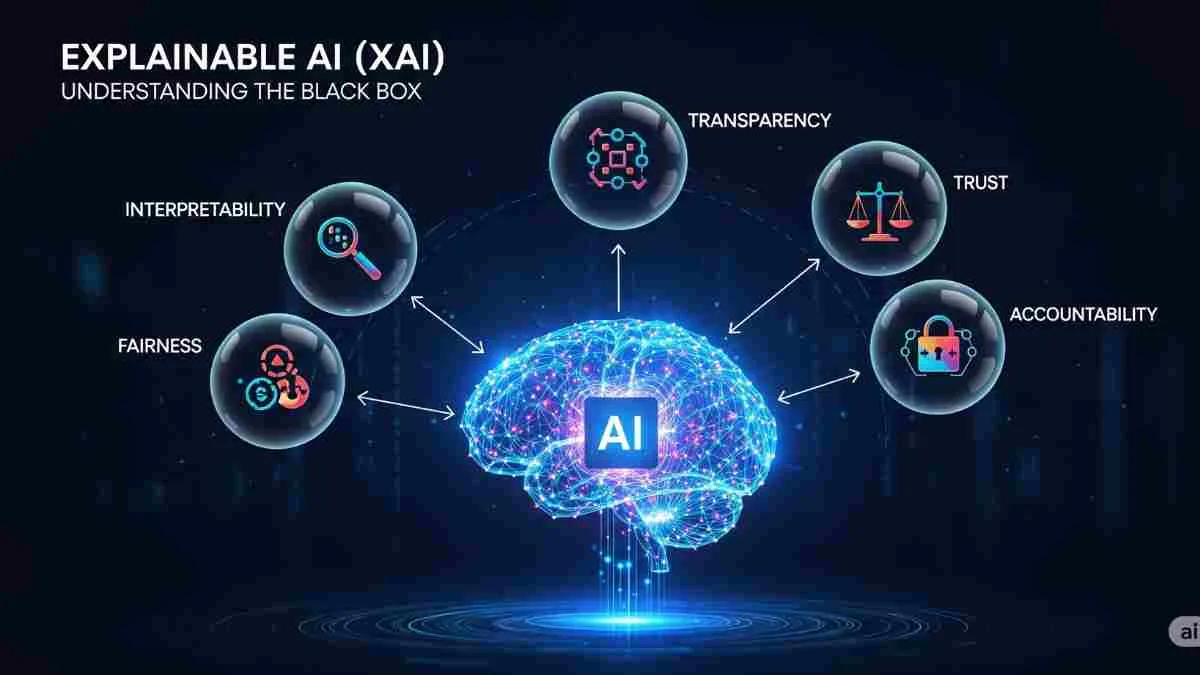Imagine you’re driving a car and suddenly the dashboard flashes a warning, but gives no explanation. Would you trust the warning? Or would you want to know what’s happening and why? This is the dilemma people face with artificial intelligence every day.
AI doesn’t just sit in the realm of fiction anymore. From hospitals to banks and from social apps to driverless cars, AI touches daily life. But there’s a catch: Most AI is seen as a “black box.” It makes decisions, but no one—not even its creators—can always tell you how or why it chose what it did.
That’s where Explainable AI (XAI) jumps in. It aims to shed light on the mystery, laying out the logic behind AI’s choices in a way we humans can understand.
Let’s walk through this fascinating story together, piece by piece, and discover why explainable AI isn’t just a fancy extra—it’s absolutely essential for trust, responsibility, and the future of technology.
Chapter 1: What Is Explainable AI—And Why Do We Need an Explanation?
Artificial intelligence is a powerful tool. But its power comes with complexity. Many cutting-edge AI algorithms, especially those behind deep learning, make decisions nobody can easily follow. These are the so-called “black box models”—we see the input and output, but the middle is a mystery.
Explainable AI (XAI) is about making those boxes transparent. It uses special techniques and processes to reveal what’s going on inside. In simple language: XAI shows how and why an AI system came to its conclusions. This could mean identifying which features influenced a loan approval, or what signals led to a medical diagnosis.
For businesses, scientists, and users, XAI is about more than just curiosity. It’s about trust and understanding. Users want to know if they can rely on an AI. Organizations want to be sure their systems are fair, accurate, and operate within the law.
Chapter 2: Why Trust in AI Matters
Imagine a bank customer denied a loan by an AI system. If the bank’s AI can’t provide a clear explanation, the customer feels frustrated and mistrustful. The same happens in medicine, law, hiring, and insurance.
People trust what they understand. When an AI can explain itself clearly, it earns user trust. That trust isn’t just nice—it’s necessary for the adoption and success of AI in high-stakes settings like healthcare, finance, and security.
Without trust, even the smartest AI remains underused and untrusted.
Chapter 3: The Building Blocks of Explainable AI
So how can an AI actually “explain” itself? Here are a few ways:
- Feature Importance: Explains which data points influenced the result most (for example, income or credit score for a loan application).
- Model Visualizations: Shows internal patterns and pathways in data.
- Decision Trees: Lays out each logical step in a simple-to-follow manner.
- Post-hoc Explanations: Uses tools to analyze and explain a black box model after it makes a decision.
One popular approach is called SHAP (Shapley Additive Explanations). It gives each input feature a “score” showing its impact on the result.
Another is LIME (Local Interpretable Model-agnostic Explanations), which explains each individual prediction in plain terms.
The goal of all these is the same: make the AI’s “thinking” visible, revealing not just what it decided, but why.
Chapter 4: Regulatory Compliance—Not Just an Option
Regulators are waking up to the importance of XAI. New rules across the world now demand AI decisions to be transparent and explainable. For example:
- GDPR in Europe: Gives people the “right to explanation” if an automated system makes decisions that affect them.
- Financial Regulations: Require banks to explain why they approve or deny loans.
- Healthcare Laws: Demand transparency when AI contributes to diagnosis or treatment.
Without XAI, companies can’t demonstrate compliance, detect bias, or guarantee fairness. Regulatory fines, lawsuits, and loss of reputation are the risks businesses face if their AI stays opaque.
Chapter 5: Accountability and Ethics—Who Answers for AI?
Let’s return to our earlier story: The car’s warning is confusing because you can’t see what’s wrong. With AI, unexplained decisions sometimes harm people—whether through denial of a service, unfair treatment, or even in critical areas like law enforcement.
Who is responsible when AI goes wrong? The company? The developers? The data? This is why accountability is so important. XAI allows organizations to:
- Trace back and justify decisions.
- Detect and fix bias or unfairness before it does harm.
- Give people the ability to challenge or appeal AI outcomes (for example, asking “why was my application declined?” and getting a sensible answer).
Ethical AI isn’t just about doing the right thing. It means building models that are both accurate and understandable. This is what earns society’s trust and paves the way for real innovation.
Chapter 6: Real Life Stories—Where XAI Matters Most
Let’s look at some areas where explainable AI changes lives:
Healthcare
- Doctors use AI to help diagnose diseases. If an AI suggests a diagnosis, both doctors and patients want to know why. XAI makes it possible for medical staff to double-check the reasoning, helping to avoid errors and improve care.
- In clinical trials, patients can understand why they’re selected for certain treatments.
Finance
- Banks rely on AI to approve loans or spot fraud. But if a loan is denied, the customer deserves a clear reason.
- Regulators require banks to show why an AI flagged a suspicious transaction, which helps prevent discrimination or bias.
Law Enforcement & Criminal Justice
- AI is used in risk assessments or predictive policing. Without XAI, these tools could reinforce bias, with no transparency.
- XAI allows for audits—verifying that the reasons behind a decision are fair and legal.
Autonomous Vehicles
- Self-driving cars use AI to make split-second decisions. When an accident occurs, knowing why the AI chose a maneuver is critical for safety investigations.
Employment
- Companies screen résumés and job applications using AI. XAI ensures that the selection process is fair, unbiased, and open to scrutiny if needed.
Chapter 7: The Roadblocks—Isn’t Explaining AI Hard?
There’s a reason not all AI is immediately explainable. Some models (like deep neural networks) are highly complex. Explaining every decision can be tricky.
But the push for XAI means researchers are constantly building new ways to make these models understandable. And as AI advances, the need for clarity rises as well.
Sometimes, there’s a tradeoff between performance and explainability. The key is balancing both—using interpretable models for high-stakes decisions and reserving black boxes for less critical tasks.
Chapter 8: The E-E-A-T Framework—How to Judge Trustworthy AI
You may have seen the term E-E-A-T:
- Experience: Has the model “learned” enough relevant information to be trusted?
- Expertise: Is it accurate and well-designed by knowledgeable professionals?
- Authoritativeness: Do reputable organizations vouch for it?
- Trustworthiness: Can it be relied on to give safe, fair, and ethical outcomes?
Explainable AI supports all these goals by letting us see what’s happening inside. If you can explain your reasoning, you’re more likely to be seen as an expert—and to cultivate trust.
Chapter 9: The Future—Why XAI Will Power the Next Wave of AI Innovation
The future of AI isn’t just about getting smarter. It’s about being more human—that means being honest, clear, and ethical.
As AI gets more powerful, organizations that embrace XAI will stand out. They’ll build trust with customers, satisfy regulators, and ensure that their systems are a force for good.
Explainable AI isn’t just a technical fix—it’s a bridge between artificial and human intelligence.
Chapter 10: Getting Started—How Can You Use or Demand Explainable AI?
If you’re a business considering AI, look for models and vendors that prioritize explainability.
If you’re a user, ask questions:
- How does this AI make its decisions?
- Can you explain or audit its output?
- What safeguards are in place for fairness and bias?
For organizations:
- Use tools like LIME or SHAP to interpret model predictions.
- Integrate XAI into your risk and compliance strategy.
- Document AI decisions and make explanations accessible to users and regulators.
Final Thoughts: The Journey from Mystery to Trust
Artificial intelligence is transforming the world. But without explainability, it risks becoming an untrusted oracle. By shining a light into the black box, XAI unlocks new levels of accountability and trust, offering everyone—from businesses and regulators to ordinary users—a clearer view of the future.
That’s why Explainable AI isn’t just a buzzword—it’s the foundation of ethical and responsible artificial intelligence. Whether you’re developing, operating, or simply living with AI, demanding explanation isn’t just your right—it’s your best defense against the unknown.
Frequently Asked Questions on Explainable AI (XAI)
1. What is Explainable AI (XAI)?
Explainable AI (XAI) refers to artificial intelligence systems that can clearly show how and why they make decisions. XAI helps turn the “black box” of AI into something transparent and understandable, allowing people to see what factors influenced the AI’s choices.
2. Why is explainability crucial in AI?
Explainability builds trust, boosts user confidence, ensures ethical use, and supports regulatory compliance. When people understand an AI’s decisions, they’re more likely to trust and accept them—especially in important fields like healthcare, finance, and law.
3. How does XAI increase trust in AI systems?
XAI allows AI systems to provide reasons for their decisions. When users can see the “why” behind results—such as why a loan was denied or why a diagnosis was given—they’re more comfortable relying on AI.
4. What techniques are used for explainable AI?
Popular techniques include feature importance analysis, model visualizations, decision trees, and post-hoc explanations with tools like SHAP (Shapley Additive Explanations) and LIME (Local Interpretable Model-agnostic Explanations). These methods help make complex models interpretable.
5. Which industries benefit most from XAI?
Industries like healthcare, finance, law enforcement, autonomous vehicles, and employment benefit most. In these fields, decisions can have a big impact on people’s lives, so clarity and accountability are essential.
6. How does XAI help with regulatory compliance?
Laws like GDPR require organizations to provide explanations for automated decisions. XAI helps companies document how their AI works and lets customers understand the reasoning behind decisions, reducing the risk of fines and legal trouble.
7. Does explainability mean AI will be less accurate?
Not always. While some simple, interpretable models might trade a bit of performance for transparency, advanced research aims to balance high accuracy with explainability. In regulated industries, simpler, more transparent models are often preferred.
8. Can black-box AI models be made explainable after training?
Yes. Post-hoc explanation tools like LIME and SHAP can interpret predictions from black-box models by analyzing which data points most influenced the outcomes.
9. What challenges does XAI face?
Some AI models are very complex, making full transparency difficult. There can be tradeoffs between performance and explainability, and explaining decisions in simple terms is still a developing area of research.
10. How can organizations start using XAI?
Organizations should look for AI solutions that offer built-in interpretability or can integrate XAI tools. Documenting AI decisions, auditing models for bias, and providing user-friendly explanations are core steps. Tools like LIME and SHAP are widely used to help with this process.
Want to learn more? Explore resources on Explainable AI and compliance or see practical examples from IBM’s explainable AI overview.











